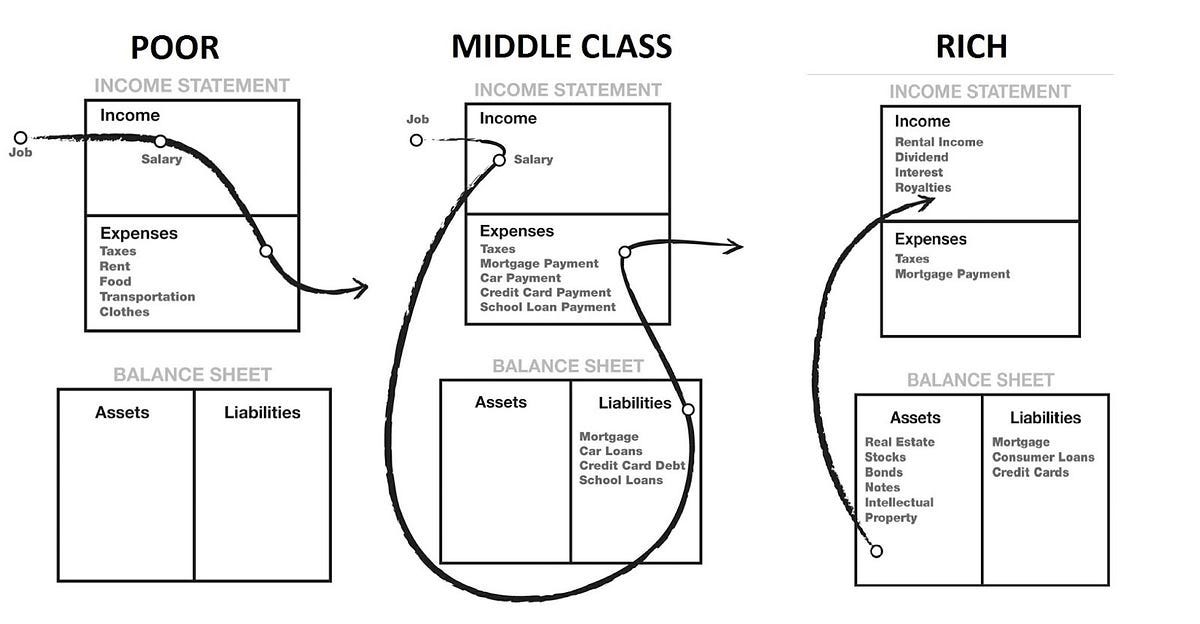Branch | Rich Dad Poor Dad
Rich Dad Poor Dad by Robert Kiyosaki focuses on the idea that words are what define your reality and that you can start improving your life by changing how you view things. In Kiyosaki’s eyes, you should never say “I can’t afford it,” but instead you should think “How can I afford it?” This slight change in phrase emphasizes a growth mindset, a mentality that results in gradual improvement over time that will leave you in a better position than the rest of your peers.
Rich Dad Poor Dad is an autobiography on personal finance by Robert Kiyosaki, a multi-millionaire real estate enthusiast. While explaining his background and how he learned about money, Robert summarizes his most valued skills and methods, especially his cash flow model, to teach you what school doesn’t: how to manage your money in a way that builds wealth over time.
“Education is more valuable than money, in the long run”
Buds | Kiyosaki’s Big Takeaways
First of all, control your money, don’t let it control you. Most people’s lives revolve around going to work solely to pay bills in the short term; many of their decisions, beliefs, and even daily moods are heavily dependent on the amount of money they have. On the other hand, Kiyosaki explains that ‘rich people’ are motivated less by cash and more by knowledge and development. They live their lives as intellectual sponges, constantly soaking in information with the ultimate goal of equipping themselves with the tools they need to succeed. Because of their focus on the journey rather than the end destination, these people tend to make more money in the long term.
Like these people, Kiyosaki says that you shouldn’t be a slave to your paycheck - obviously, you need the cash sometimes, but learn to think in the long term. Your current job is only funding your personal investments, and your best asset is your mind, not your income. The moment you start working for a paycheck, you start thinking like an employee. Work for knowledge, and take the paycheck as a bonus that comes alongside it to fuel assets like stocks that can grow your wealth exponentially.
“The poor and middle-class work for money. The rich have money work for them”
Another one of Robert’s favorite pointers is that you should “mind your business”, and stick to what you know. Sometimes people will offer you jobs or opportunities that seem like great deals, but really you don’t have the time, energy, or knowledge for these separate projects. Focusing on your own lifestyle is usually best for you in the long term, and keep in mind that you should rarely agree to something that you won’t benefit from.
“The size of your success is measured by the strength of your desire.”
Finally, Robert emphasizes the absolute importance of understanding the difference between an asset and a liability when it comes to financial literacy. Understand the difference between an asset and a liability. An Asset is something you invest in or acquire that produces cash flow and creates additional value. On the other hand, a Liability is something you buy that retains or loses its original value. In simple terms, Assets put money in your pocket and Liabilities take money. out of it. Many people buy liabilities thinking they are assets; a house or a new car may be the most valuable things a person owns, but in actuality are liabilities because they represent a financial loss. The rich get richer by buying assets like stocks, bonds, and rentable real estate, while the poor get poorer because they buy things like houses, cars, and jewelry.
“There is a difference between being poor and being broke.
Broke is temporary. Poor is eternal”
Leaves | The Cashflow Model
If you had to learn one thing from RDPD, it should be how to implement his cash flow model to measure and track your own finances. In short, Robert analyzes how different people spend/invest their money, and how that affects their financial livelihood. The model consists of two comparisons: your income statement, and your balance sheet. Your income statement measures your income against your expenses, and your balance sheet tracks your assets against your liabilities.
The idea of this model is that it provides a map showing your individual cash flow: where your money is coming from and being used for. This specific model also demonstrates what type of portfolio you want to have to become more financially stable. In summary, poor people’s expenses eat up the entirety of their income, making it difficult to invest. The middle class buys liabilities with their income thinking they are assets, which adds to their expenses and prevents them from becoming rich. Finally, the wealthy use their income to buy assets, which eventually pay for their expenses and add to their income statements. This model is easy to create for yourself, and I’d recommend trying it out to see where you fall, as well as how you can improve your situation.
Although I covered most of the important pointers from Rich Dad Poor Dad, I highly recommend reading it for yourself. Inside the book are additional methods to learn about money, Kiyosaki’s opinion on College, and many more pieces of both financial and life advice that completely changed the way I look at money. Overall it’s a pretty straightforward read and is without a doubt a book that will give you an advantage regardless of your age, experience, or financial background.








